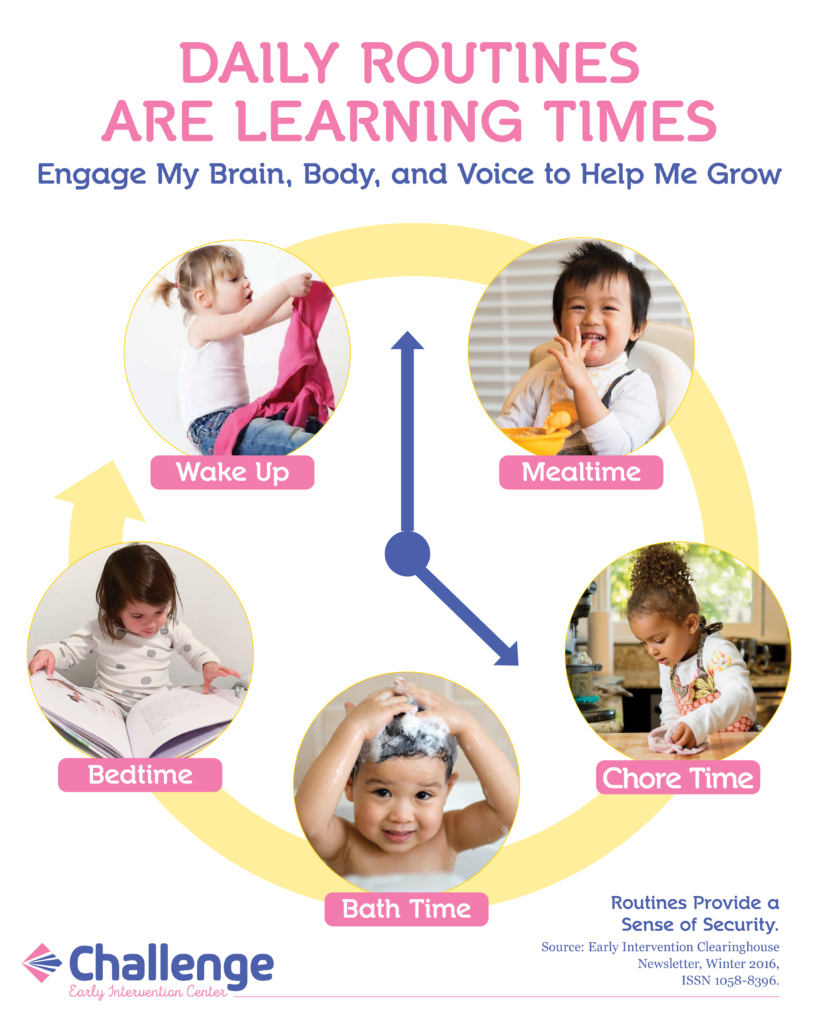Source: Early Intervention Clearinghouse Newsletter, Winter 2016, ISSN 1058-8396.
 Think about how you begin your day. Are there certain things that happen for you to feel awake and ready to tackle your day? Coffee, a shower, quiet time? Our morning routine can set the tone for the rest of the day. What about your children? Do they have certain “rituals” during their day?
Think about how you begin your day. Are there certain things that happen for you to feel awake and ready to tackle your day? Coffee, a shower, quiet time? Our morning routine can set the tone for the rest of the day. What about your children? Do they have certain “rituals” during their day?
From the beginning, we probably create routines with a newborn. We may feed her in a certain chair every time. We may sing the same songs at bedtime or use the same loving voice when we change his diaper. It is during these early routines that we develop close relationships with our children. They know that they can count on us to meet their basic needs. It also allows us to truly be in tune with our child’s responses.
Routines help young children know what they can expect next. This helps them feel secure and gives them stability. They can also feel more relaxed and calm. It is important to understand the difference between a routine and a schedule.
A schedule is a general timetable of how you would like for your day to happen. For example: 9 a.m. playgroup, 11:30 a.m. lunch, 12:30 p.m. nap, 3 p.m. grocery store, 5:30 p.m. dinner, 7:30 p.m. bedtime for kids, and then quiet time for parents.
A routine can be described as the usual sequence for a set of activities, but it is not usually attached to times on the clock. For example, in the morning you get up, get dressed, and eat breakfast and before going to bed you take a bath, brush your teeth, and read a book before going to sleep.
Routines are usually repeated every time, but schedules can change from day to day, especially on the weekend.
As children grow and develop, they can take on some of their own tasks within a routine, such as washing their hands or feeding themselves. They may also begin to resist certain tasks because they don’t want to stop what they’re doing. Think of a wiggly child who doesn’t want to stop playing to get his diaper changed.
Routines can also help in day-to-day family life and reduce household stress. If a young child’s routine includes putting toys away after she plays with them, she may be more willing to help clean up tomorrow, and the next day, and the next. This does not happen automatically. It takes consistency and repetition from caregivers.
Establishing a routine can happen naturally. Think about what usually happens in the morning and what changes you would like to make for the morning to run more smoothly.
Once the routine feels like it is working, stick to it. Evening routines also can prepare you for the next day, such as laying out clothes. Weekends provide a different schedule, but with similar routines, children can manage change.
Routines in Early Intervention
There are several questions parents can ask providers to help get started:
It might also be helpful for the team to record this information so it can be referenced between visits. One way to do this would be to list all of the routines that the family would use and then outline the strategies that can be addressed during each routine. The chart below outlines possible strategies that can be incorporated into different routines.
| Meals | Diaper Changes | Laundry | |
|---|---|---|---|
| Language | Work on signs: more eat drink please | Identify body parts: nose ears eyesetc. | Identify items: socks shirt pants |
| Fine motor | Pincer grasp to pick up finger foods hold cups; practice using utensils | Play with toys; practice using zippers and large buttons | Let child try to put on socks or other clothes |
| Gross motor | Practice pull to stand; climbing into high chair (with close supervision) | Rolling; transition to sitting; stretching | Push basket; pull to stand by overturned basket; toss socks into basket |
| Social/emotional | Peek-a-boo with wash cloth or cloth napkin | Talk about what you’re doing and what you’ll do next. | Talk about the clothes as you fold them |
| Sensory | Opportunities to play with food; finger paint with applesauce or pudding | Talk about the cool wipes or the texture of the clothes | Talk about the texture of the clothes: soft; scratchy; smooth; rough |
Adapted from “Embedding Strategies into Family Routines: One PT’s Perspective (Part 2)” by Kim Lephart, PT, DPT, MBA, PCS
This process is called embedding strategies into daily routines. By asking yourself the above questions, you will soon be able to find strategies and activities that are appropriate for your child and family. With enough practice and planning, this may even become a natural part of your daily routine!
This article, and many more wonderful resources for parents and professionals, may be found online in English and Spanish at https://eiclearinghouse.org/
